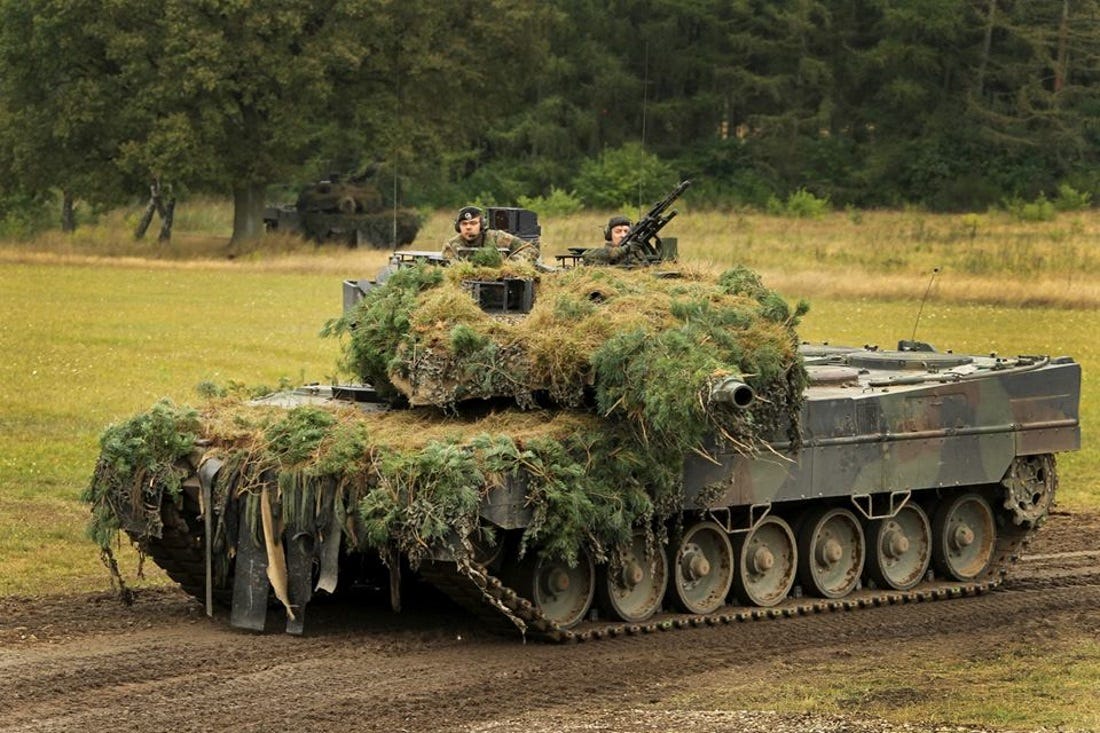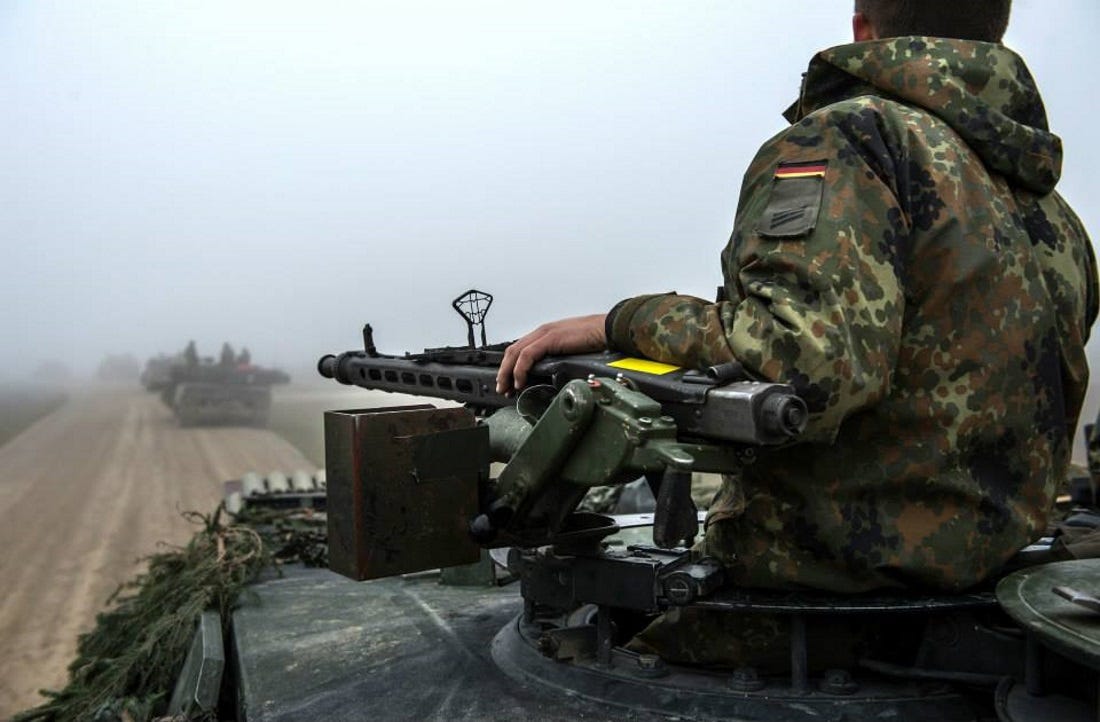by THOMAS NEWDICK
Since first sending small numbers of unwieldy A7Vs into combat on the Western Front in March 1918, German armor designers have produced some of the finest tanks in history.

There were the early Panzers that spearheaded Blitzkrieg warfare in the early years of World War II, and the Panther medium tank that heavily influenced post-war fighting vehicle design. And don’t forget the colossal Tiger I.
During the Cold War, Germany continued its line of world-beating war machines with the Leopard 1, packing the classic British 105-millimeter L7 gun. The Federal Republic built 5,000 first-generation Leopards starting in 1965, and today hundreds of the next-gen Leopard 2s remain in front-line service.
Now to keep the tanks relevant, the German Bundeswehr is developing add-on kits and other modifications.
The upgraded Leopard 2A7 is all about adapting to the demands of unconventional warfare.
The baseline Leopard 2 entered service in 1979 to help NATO blunt a potential Warsaw Pact armored invasion. The new armored vehicles replaced many of the older, first-generation Leopards.
One of the best tanks in the world when it comes to blending firepower, protection and maneuverability—the Leopard 2 remains the German army’s standard main battle tank.
Export models serve with more than a dozen countries, and Saudi Arabia has lined up a big new order. That is, if the deal gets past a skeptical German parliament.
While a main battle tank may be costly, laborious to deploy and of potentially limited value in an urban scenario, no other fighting vehicle has the same sheer destructive power—or the psychological impact—on the battlefield.
In December, the German army received its first upgraded 2A7 tanks. The latest design from manufacturer Krauss-Maffei Wegmann improves on the previous Leopard 2A5, 2A6 and the Leopard 2 PSO.
But what makes the 2A7 different is that it includes changes based on experience gained in Afghanistan. Berlin’s NATO contingent did not deployLeopard 2s to Afghanistan. But Canada and Denmark—which also operate the tanks—did.
On the outside, the 64-ton Leopard 2A7 looks familiar. Its primary weapon remains the smoothbore Rheinmetall 120-millimeter gun. But the new cannon has fully-electric controls and better ammunition.
The tank fires armor-piercing, fin-stabilizing discarding sabot rounds and programmable, high-explosive shells.
Effective out to a range of 5,000 meters, the HE rounds have a “dial-up” mode for targets ranging from armor plates to clay brick walls. These are particularly effective against bunkers and fortified positions, making the HE ammo preferable in urban terrain.
The Germans originally planned to include a remotely-operated .50-caliber machine gun, but the designers dropped it owing to cost.
To give the crew a better sense of their surroundings, the tank has a stabilized panoramic sight mounted on the roof. The sight has a third-generation thermal imager, laser rangefinder and a charge-coupled device camera. The gunner’s thermal sight also got an update.
Plus, the 2A7’s crew members carry tablet computers. These integrate with a new command-and-control information system, displaying real-time updates on the location of friendly and hostile forces.
 A German tank column in heavy fog during NATO exercises. Germany army photo
A German tank column in heavy fog during NATO exercises. Germany army photo
The ever-present threat of improvised explosive devices in Afghanistan influenced the Leopard 2A7’s armor, and a heavier underbelly. When necessary, the Germans can add an extra layer of passive armor to the vehicle’s sides.
There’s more useful hardware, including an air-conditioning system for the crew compartment and the powerplant. There’s also an auxiliary power unit that allows the tank’s subsystems to run with the main engine switched off.
In addition to keeping things cool, running power off the auxiliary unit reduces fuel consumption, keeping the tank quiet and boosting battery life.
The air-conditioning system is a very welcome feature in desert regions, where the temperature inside the hull can sometimes hit 158 degrees Fahrenheit.
Eventually, the German army wants to modify its entire fleet of Leopard 2A6s—roughly 200 tanks—to 2A7s. Berlin bought the first batch of 20 tanks from The Netherlands before upgrading them. Canada had previously leased the tanks from the Dutch army for use in Afghanistan.
The first batch of upgrades finished on time, and stands out as a rare success story for the troubled German military. Two all-new fighting vehicles for the army—the Boxer wheeled armored personnel carrier, and the Puma tracked infantry fighting vehicle—have both suffered from embarrassing delays, budget overruns and cutbacks.
And there’s a larger reason why Germany still sees a place for the main battle tank. Russia’s increasingly aggressive stance in Eastern Europe is providing a timely reminder of the value of heavy armor.
The Dutch, who at one time planned to scrap their entire tank force, are also now having second thoughts.
Meanwhile, the German army is planning another new Leopard upgrade—focusing on improvements to the tank’s vision system. Beyond that, plans are afoot to develop an entirely new armored beast, tentatively called the Leopard 3.
Last fall, a cross-party government committee released a budget proposal that included a significant increase in armored vehicles for the futureBundeswehr. With the Kremlin rattling its sabers, the planned 225 Leopards and 190 Boxers are no longer adequate, the lawmakers claim.
The committee advocated modernizing existing tanks and also developing the so-called Leopard 3. Exactly what this new monster might look like remains unclear, and the politicians didn’t specify how much it should cost.
Certainly, such a project would face competition from other big-ticket programs, including a new air-defense system and the Infanterist der Zukunftfuture soldier initiative.
But the Germans are still interested in continuing their tank dynasty.
No comments:
Post a Comment